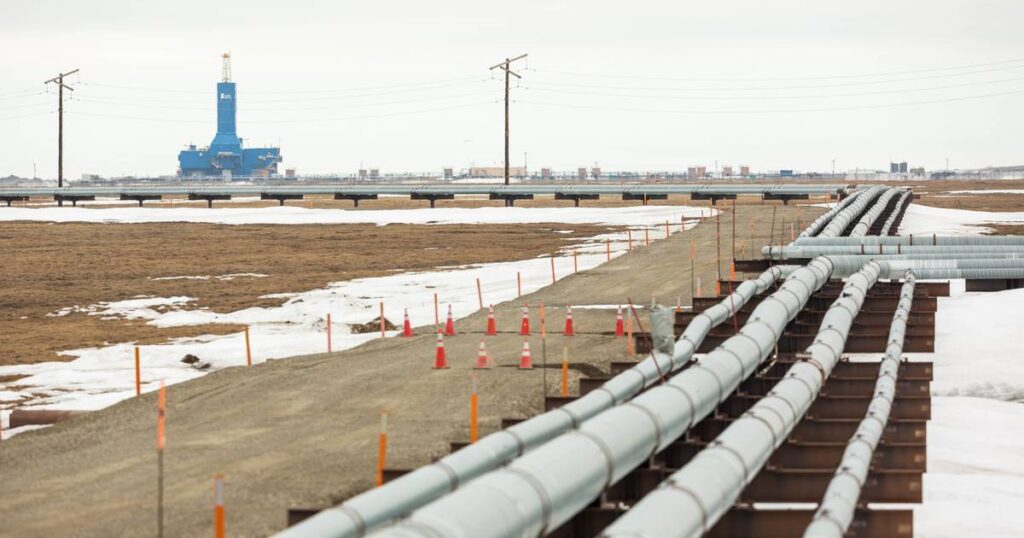![]()
Suppose I go to a banker and say that I want to buy a million dollar house, but right now I can only afford a $50,000 house. But one day I might be able to afford a million dollar house. And I ask the banker for the million dollars. If the banker is polite, he will just say no, without making any critical comments or giving me any funny looks.
This is essentially the Alaska Gasline Development Corporation’s (AGDC) latest plan to fund a North Slope natural gas pipeline to south-central Alaska.
AGDC has not been able to commercialize a liquefied natural gas export project since it was founded 11 years ago. Their vision is a 42-inch, 800-mile pipeline capable of transporting 3.5 billion cubic feet of gas per day, some of which would be used for consumption in southcentral Alaska. Gas consumption in southcentral Alaska is currently about 70 billion cubic feet per year, or 190 million cubic feet per day. So if North Slope gas replaced all of Cook Inlet gas, about 5% of the pipeline capacity would be used in southcentral Alaska.
AGDC estimated the pipeline would cost $10.7 billion, but that was in 2019, before COVID and inflation. No one knows what it would cost today, but it would certainly be much more. The additional infrastructure to liquefy the gas for export is also expected to be very extensive, estimated at the time to be in excess of $30 billion.
Unable to put together an export project, AGDC introduced the concept of a “phased development” in February: Phase 1 would be just the 42-inch pipeline, which it says could deliver gas to south-central Alaska by 2029. Phase 2 would be everything else if an export project becomes viable, if that's even possible.
There is simply too much competing gas (that can be brought to market at a lower cost) for exports from the North Slope to be practical. The rest of the world has roughly 200 times as much gas reserves as the North Slope. Much of this gas is in the intertidal zone, and unlike Alaskan gas, it doesn't require long, expensive pipelines to transport the gas to the starting points of all those other projects.
So the AGDC plan is to somehow fund a multi-billion dollar pipeline, but 95% of that pipeline will sit empty for years, possibly forever. AGDC has never identified a company that will fund this pipeline or how. This is like me trying to take out a million dollar mortgage. Local consumers will only be able to pay 5% of the cost. I hope AGDC doesn't rely on the public for the rest of the cost.
AGDC recently announced, with its usual publicity hype, that it had signed agreements with small producers to supply gas (if there is a pipeline) for Phase 1 (if there is one).
Making this possible comes at a cost. First, millions of dollars the state has allocated to AGDC over the years could have been spent on education, public safety, roads, and other parts of Alaska’s vast aging infrastructure.
Second, the hype around the project creates unrealistic expectations and diverts attention from serious solutions to the real problem: Southcentral Alaska is running out of gas. The more citizens believe that North Slope gas is economically viable, the more attention is diverted from the need to secure viable alternative sources of supply. Southcentral Alaska will likely need to import LNG soon. Given the large amount of additional supply coming onto the global market in the coming years, global LNG prices are expected to fall, potentially making it competitive with current Cook Inlet prices. These imports will also constrain the amount that the current monopoly Cook Inlet supply structure can charge.
But accommodating imports would require significant infrastructure with long lead times. These requirements need to be addressed quickly. Raising false hopes that North Slope gas will be available will only undermine the extensive planning efforts that need to be undertaken.
Roger Marks is an economist in private practice in Anchorage. He was the senior petroleum economics specialist for the Alaska Department of Revenue and Taxation from 1983 to 2008. He has no financial ties to the oil industry.
Opinions expressed here are those of the author and are not necessarily endorsed by the Anchorage Daily News, which welcomes a wide range of viewpoints. To submit an article for consideration, email commentary(at)adn.com. Submissions of under 200 words may be sent to letters@adn.com or click here to submit from any web browser. Read our complete guidelines for letters and commentary here.



